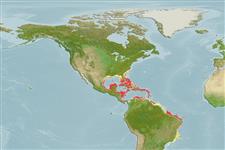Environment: milieu / climate zone / depth range / distribution range
Sinh thái học
Biển Cùng sống ở rạn san hô; Mức độ sâu 1 - 60 m (Ref. 9710), usually 1 - 40 m (Ref. 27115). Tropical; 22°C - 27°C (Ref. 27115)
Western Central Atlantic: Bermuda, Bahamas, and Central America to northern South America.
Length at first maturity / Bộ gần gũi / Khối lượng (Trọng lượng) / Age
Maturity: Lm ?, range 3 - ? cm
Max length : 8.0 cm TL con đực/không giới tính; (Ref. 7251)
Các tia vây lưng cứng (tổng cộng) : 12; Các vây lưng mềm (tổng cộng) : 10. Bicolored: purple (appearing blue underwater) in front, bight orange-yellow behind (Ref. 26938).
Often found in caves or under ledges. Swim with belly toward substratum, thus under ledges seen upside down. Feed on ectoparasites of other fishes (Ref. 5521). Males show various types of nest care behavior (Ref. 35580). Retreat into recesses when alarmed (Ref. 9710). Have been reared in captivity (Ref. 35420).
Mouthbrooding in this specimen has not been supported by any evidence (Ref. 35580). Prior to spawning, some males established nest sites, using small holes and crevices in the substratum. Females traveled to male nests for egg deposition around dawn. Eggs deposited within the nests were tended by males that established the nests. Males display four types of nest care behaviour: guarding, nest maintenance, detritus clearing,and simple nest entering (Ref. 35580).
Asoh, K. and T. Yoshikawa, 1996. Nesting behavior, male parental care, and embryonic development in the fairy basslet, Gramma loreto. Copeia 1996(1):1-8. (Ref. 35580)
IUCN Red List Status (Ref. 130435)
Threat to humans
Harmless
Human uses
Các nghề cá: Tính thương mại; Bể nuôi cá: Tính thương mại
Các công cụ
Special reports
Download XML
Các nguồn internet
Estimates based on models
Preferred temperature (Ref.
123201): 25.1 - 28, mean 27.1 °C (based on 436 cells).
Phylogenetic diversity index (Ref.
82804): PD
50 = 0.5313 [Uniqueness, from 0.5 = low to 2.0 = high].
Bayesian length-weight: a=0.01122 (0.00514 - 0.02450), b=3.04 (2.87 - 3.21), in cm total length, based on all LWR estimates for this body shape (Ref.
93245).
Mức dinh dưỡng (Ref.
69278): 3.3 ±0.41 se; based on food items.
Fishing Vulnerability (Ref.
59153): Low vulnerability (10 of 100).
Nutrients (Ref.
124155): Calcium = 115 [64, 202] mg/100g; Iron = 0.81 [0.50, 1.29] mg/100g; Protein = 18.6 [17.5, 19.6] %; Omega3 = 0.173 [0.105, 0.280] g/100g; Selenium = 25.4 [12.9, 46.5] μg/100g; VitaminA = 184 [63, 540] μg/100g; Zinc = 2.18 [1.51, 3.03] mg/100g (wet weight);
